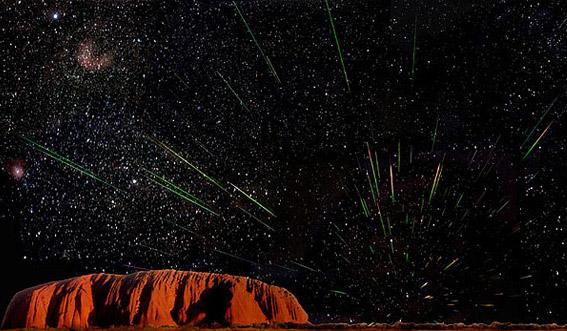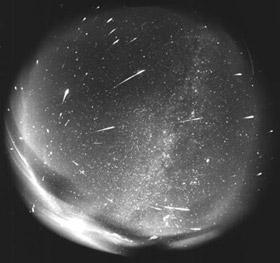Tonight—Friday. Nov. 16—the Leonid meteor shower will be at its peak, with 20 to 30 or so shooting stars visible per hour. If you’ve ever wanted to sit outside and soak up a meteor shower, the next few nights are your big chance: The Moon is new, so it won’t interfere at all with the shower. And if tonight’s no good for you, that’s OK, because Saturday and Sunday will be just fine as well. I’ve got a list of what you need to do to watch the shower, but first, let me give you a brief intro to the what’s what with the Leonids.

Image credit: ICSTARS.
The comet Tempel-Tuttle orbits the Sun every 33 years. Comets are essentially dirty snowballs, made of gravel, rock, and dust frozen together in ice. When Tempel-Tuttle gets near the Sun, it heats up and sheds a lot of debris. Due to the geometry of its orbit, every year the Earth passes through this debris in November. Mostly it’s very tiny pieces of rock, smaller than grains of sand. When the Earth plows into them, they enter our atmosphere at high speed, compressing the air in front of them violently, heating them up, and causing them to glow.
Because the comet orbits the Sun more-or-less in the opposite direction the Earth does, we ram these little fellas head-on, making them much faster (and therefore brighter) than the typical meteors. They blast into our air at speeds up to 70 kilometers per second (40 miles per second)! So they really zip across the sky. I’ll note we’re in no danger from meteor showers like this despite every sci-fi movie you’ve ever seen. They burn up 100 kilometers (60 miles) above the ground. What you get is a fun light show, not bombs falling all around you. So all you have to do is go outside and enjoy.
And how do you enjoy it, exactly? Ah, glad you asked! Here’s what you need to watch this lovely celestial show.
1) A wide open sky with a view to the east
This is the biggest consideration. Meteors appear in random spots on the sky and can go from horizon to horizon. The more sky you can see, the more meteors you’ll see. Try to avoid nearby buildings, trees, and so on.

Image credit: Wikipedia/Modra Observatory
If you trace the path of the meteors backward, they will appear to radiate from one point in the sky, located in the constellation Leo (hence the name Leonids). This is the same effect as when you’re driving a car through a tunnel and the lights on the walls and ceiling appear to come from the point ahead of you.
Leo rises in the east after midnight, so a clear sky in that direction helps a lot. This isn’t critical, though; just a big wide view is your best bet.
2) Dark skies
Meteors are generally not terribly bright. A few can be blazing, but most are about as bright as your average star, so you want to be away from lights. Your back yard might be fine, but make sure street lights are blocked and your house lights are off.
3) Time
The best time to go out and look is after midnight: That’s when the part of the Earth you’re standing on is facing into the oncoming meteors. It’s the same thing when you’re driving through rain and more drops hit your front windshield than the rear, in fact! You might see a few meteors before midnight, but the later you go out, the better.
Once you’re outside, it takes about 20 minutes for your eyes to get fully adapted to the dark—your pupils dilate, letting in more light, and your eye produces a light-sensitive protein called rhodopsin that helps see faint objects. Both of these take time to fully kick in. So don’t be disappointed if you see very few or no meteors right away. White light will bleach the rhodopsin, by the way, so if you need some light, use a flashlight with red cellophane covering the front. That will preserve your night vision.
4) A lounge chair
You need to be able to see a lot of the sky for minutes or hours, so you want to be comfortable. A chaise lounge or a folding beach recliner is a big plus. You can lie on the ground with a blanket if you want, but comfort is important if you’re going to be out for a while. The ground tends to be cold at night, and wet, too. Which reminds me …
5) Blankets!
Hey, it’s November! You want to stay warm, and you won’t be moving much lying on your back, so you won’t be generating much heat. Hot chocolate is not required, but why wouldn’t you have some at the ready? Also …
6) A hat
You lose a good amount of heat through your head, so I strongly urge you to wear a hat, especially if, like me, you are follically challenged. Plus, if you have a nearby street light, you can position your hat to block it. I do this myself and it works pretty well.

Image credit: Randy Halverson
7) Telescope, binoculars
I recommend not using a telescope. Why not? Telescopes see only a small part of the sky, and meteors appear in random spots. I guarantee the best meteor of the night will happen while you are stooped over an eyepiece, and you’ll miss it. However, Jupiter is well positioned for viewing, so this is as good a chance as any to do some observing, and I hate to tell people to not take advantage of a nice night! But be prepared to hear everyone else gasp and then mock you for missing the best meteor evah.
Binoculars are better. You can scan the sky, look for interesting things, and still be able to look around quickly if a bright meteor appears.
8) Star chart
You’ll be outside! Why not get familiar with the sky? You can find charts at local bookstores, and online if you do a little searching. Orion, Taurus, the Pleiades … this is a fine time of year to be out looking for cosmic landmarks.
9) Rest
Oh boy, is this one important. It’s after midnight, you’re lying down, snuggled in a blanket, it’s dark, and your eyes are focused on infinity. You start daydreaming a bit … and the next thing you know, the Sun is rising and you missed the show. The good news for the Leonids this year is they peak over the weekend, so staying up is a little easier.
10) Friends, family, neighbors
Having other folks with you will help you stay awake, and honestly, the joy and beauty of a meteor shower is best shared. One of my favorite times ever with my daughter was watching the Leonids shower years ago. She had a blast, and not just because she got to stay up until 3:00 a.m. with her dad … but then again, that’s a big part of it, too.
11) An appreciation of what you are seeing.
Read up on meteor showers, what they are, what we’ve learned from them. Comets orbit the Sun for billions of years, and you’re seeing teeny tiny parts of them cast off as detritus as they slam into our atmosphere a hundred miles away at speeds of up to 40 miles per second. How amazing is that?
12) Wonder
This may be the best thing to bring, and the easiest. Meteor showers are simply wonderful. It’s a cosmic show, and it’s free, and it’s very, very cool. Go out and look!